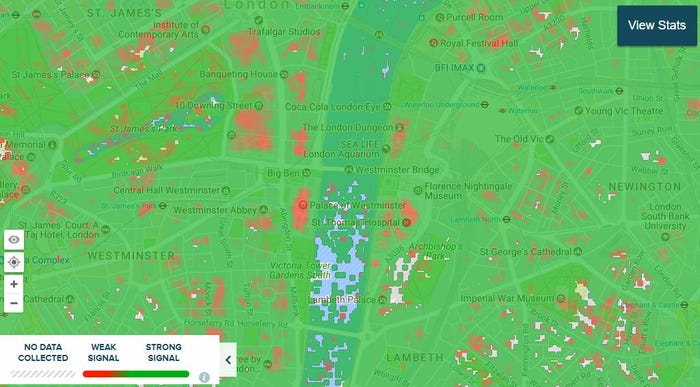Mobile network experience in Scotland - in order to get it right we need to understand what is wrong
The way that coverage is currently measured has a lot of limitations. Talking about 99% population coverage paints a very rosy picture of a rather grim tale.
March 8, 2018

Telecoms.com periodically invites third parties to share their views on the industry’s most pressing issues. In this piece Brendan Gill, CEO of OpenSignal, looks at the complexities of accurately measuring mobile signals.
Scotland has been struggling to keep up with the rest of the UK in terms of digital connectivity for many years. Official figures from Ofcom show that a mere 17% of Scotland has 4G mobile coverage, compared to 60% in England. And although there have been several initiatives launched by the Scottish Government to address this – such as The Mobile Action Plan, or the R100 programme pledging to deliver superfast broadband access to 100% of premises in Scotland by 2021 – the gap remains visible in key connectivity metrics.
In most cases the debate has centred around how Scotland’s consumers are being left behind. But erratic connectivity, especially in mobile services is having an impact and hurting businesses as well.
It’s being measured wrong
“Fixing” Scotland’s connectivity issue can only start once there is a clear understanding of what the problem is. Taking it a step further, if problems are not identified and quantified correctly, they serve merely as a distraction, delaying the process of finding a solution. In the wireless world, the distractors are the measurements used to quantify 4G connectivity.
The way that coverage is currently measured has a lot of limitations. Talking about 99% population coverage paints a very rosy picture of a rather grim tale. It’s vital that the right metrics are in place to truly assess – and address – the problem. Only then can the discussions begin on how it can be fixed.
So how does the industry get it right? One approach, from the likes of OpenSignal, is to look at time. Specifically, the percentage of time users are able to connect to an LTE signal. This draws a much more realistic picture of the everyday mobile network experience by collecting and analysing data from smartphones wherever their owners are: indoors or out, in the city or the countryside, day or night. The metric, called 4G availability, shows Scotland (as well as the UK in general) still has a long way to go before reaching that coveted 99%.
By relying on real-world data, the availability approach eliminates the pitfalls that other coverage metrics so easily fall into: such as disregarding population density (i.e. geographic coverage) or failing to measure coverage indoors or at any location other than your home (i.e. population coverage).
Indoor coverage needs to be part of the equation
In fact, the majority of service fluctuations and black spots occur inside homes and offices. And many operators currently lack the means to track, let alone address the issue.
Population coverage is often talked about, and typically looks at: is there a signal at your doorstep? That would be great if all mobile devices were only used on doorsteps. But the reality is mobile users go inside, and there is a huge differential between the signal received outside and inside homes.
Searching for a signal at home, in the supermarket or in the Palace of Westminster itself should not be a source of frustration. But as we look at the coverage map below (built based on real-world user data), it’s clear that Parliament’s indoor coverage is close to non-existent, while the surrounding areas all indicate strong signals.

2 days less connectivity
The reality is that national 4G availability statistics are troubling – UK-wide we are talking about between 58% and 78% – and that is between the different providers. There is a big difference between this and the 99% population coverage figure that so many in the industry like to use.
As for Scotland, we were seeing around 7% less time connected to 4G compared with the UK nationwide average. It might not seem like a lot, yet 7% of the time is potentially two days per month when a mobile user in Scotland is not connected to 4G, but the UK-wide average is.
There is clearly a long list of unique challenges hindering 4G connectivity in Scotland, ranging from population spread to difficult terrain; but before the industry can start working on solving the issue, they first need to make sure that the metrics are right.
 Brendan Gill is the CEO of OpenSignal, a company he co-founded in 2010. He has spent over 10 years providing solutions to help people understand and improve mobile service and experience. Prior to OpenSignal, Brendan was part of the team that launched RepeaterStore in 2007, which provides signal boosting solutions to improve wireless cell and data reception in buildings, homes and vehicles. Brendan is listed in the Global Telecoms Business Power100 2017 as one of the most powerful names behind the telecoms sector. He is an accomplished speaker and has presented at leading industry events including: CTIA, Mobile World Congress, TechCrunch Mobile and the Qualcomm CEO Summit.
Brendan Gill is the CEO of OpenSignal, a company he co-founded in 2010. He has spent over 10 years providing solutions to help people understand and improve mobile service and experience. Prior to OpenSignal, Brendan was part of the team that launched RepeaterStore in 2007, which provides signal boosting solutions to improve wireless cell and data reception in buildings, homes and vehicles. Brendan is listed in the Global Telecoms Business Power100 2017 as one of the most powerful names behind the telecoms sector. He is an accomplished speaker and has presented at leading industry events including: CTIA, Mobile World Congress, TechCrunch Mobile and the Qualcomm CEO Summit.
Passionate about empowering and supporting entrepreneurship, Brendan founded BetaFoundry, an accelerator programme offering mentors and advisors for students to encourage them to choose an alternative to the standard career path. In addition, he is one of the TechStars London mentors, and has taken the FoundersPledge to encourage tech entrepreneurs to donate to charitable causes. Brendan holds a degree in Physics and Philosophy from the University of Oxford.
Read more about:
DiscussionAbout the Author(s)
You May Also Like








.png?width=300&auto=webp&quality=80&disable=upscale)


_1.jpg?width=300&auto=webp&quality=80&disable=upscale)


.png?width=800&auto=webp&quality=80&disable=upscale)